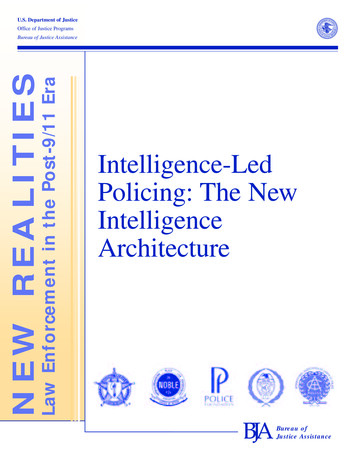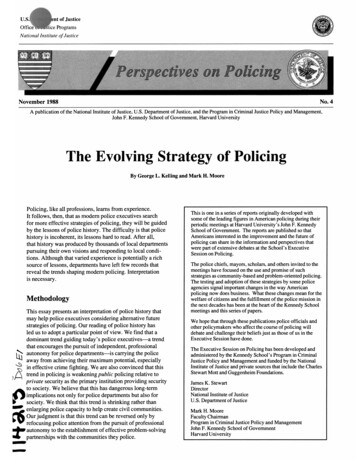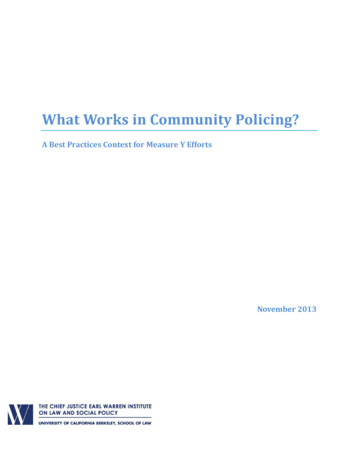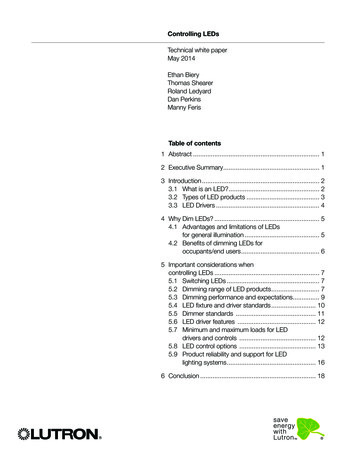
Transcription
U.S. Department of JusticeOffice of Justice ProgramsLaw Enforcement in the Post 9/11 EraNEW REALITIESBureau of Justice AssistanceIntelligence-LedPolicing: The NewIntelligenceArchitectureBureau ofJustice Assistance
U.S. Department of JusticeOffice of Justice Programs810 Seventh Street NW.Washington, DC 20531Alberto R. GonzalesAttorney GeneralRegina B. SchofieldAssistant Attorney GeneralDomingo S. HerraizDirector, Bureau of Justice AssistanceOffice of Justice ProgramsPartnerships for Safer Communitieswww.ojp.usdoj.govBureau of Justice Assistancewww.ojp.usdoj.gov/BJANCJ 210681Written by Marilyn PetersonThis document was prepared by the International Association of Chiefs of Police undercooperative agreement number 2003–DD–BX–K002 awarded by the Bureau of JusticeAssistance, Office of Justice Programs, U.S. Department of Justice. The opinions, findings,and conclusions or recommendations expressed in this document are those of the authorsand do not necessarily represent the official position or policies of the U.S. Department ofJustice.The Bureau of Justice Assistance is a component of the Office of Justice Programs, which alsoincludes the Bureau of Justice Statistics, the National Institute of Justice, the Office of JuvenileJustice and Delinquency Prevention, and the Office for Victims of Crime.
Intelligence-LedPolicing: The NewIntelligenceArchitectureSeptember 2005NCJ 210681Bureau ofJustice Assistance
AcknowledgmentsPost 9/11 Policing Project StaffThe Post-9/11 Policing Project is the work of theInternational Association of Chiefs of Police (IACP),National Sheriffs’ Association (NSA), NationalOrganization of Black Law Enforcement Executives(NOBLE), Major Cities Chiefs Association (MCCA), andPolice Foundation. Jerry Needle, Director of Programsand Research, IACP, provided overall project direction. Dr. Ellen Scrivner, Deputy Superintendent,Bureau of Administrative Services, ChicagoPolice Department, contributed to all phases ofproject design and cofacilitated the Post-9/11Roundtables with Jerry Needle. MarilynPeterson, Management Specialist–Intelligence,New Jersey Division of Criminal Justice,authored this monograph—Intelligence-LedPolicing: The New Intelligence Architecture.National Sheriffs’ AssociationFred Wilson, Director of Training, directedNSA project activities, organized and managedPost-9/11 Roundtables, and worked closely withIACP staff throughout the course of the project.NSA project consultants included Chris Tutko,Director of NSA’s Neighborhood Watch Project;John Matthews; and Dr. Jeff Walker, Universityof Arkansas, Little Rock.National Organization of Black LawEnforcement ExecutivesJessie Lee, Executive Director, served asNOBLE’s Project Director and conducted moststaff work. Major Cities Chiefs AssociationDr. Phyllis McDonald, Division of Public SafetyLeadership, Johns Hopkins University, directedthe work of the Major Cities Chiefs Association.The MCCA team included Denis O’Keefe,Consultant; Corinne Martin, ProgramCoordinator; and Shannon Feldpush.International Association of Chiefs of PolicePhil Lynn served as IACP’s Project Director,managed development and publication of thefour Promising Practices Briefs, and authoredMutual Aid: Multijurisdictional Partnerships forMeeting Regional Threats. Andrew Morabitocoauthored Engaging the Private Sector ToPromote Homeland Security: Law EnforcementPrivate Security Partnerships, and analyzedPost-9/11 survey data. Col. Joel Leson, Director,IACP Center for Police Leadership, authoredAssessing and Managing the Terrorism Threat.Walter Tangel served as initial Project Director. Dr. Sheldon Greenberg, Director of the Divisionof Public Safety Leadership, coauthoredEngaging the Private Sector To PromoteHomeland Security: Law Enforcement-PrivateSecurity Partnerships. The Police FoundationEdwin Hamilton directed Police Foundationproject activities and managed Post-9/11 surveyformatting and analysis, assisted by Rob Davis.Foundation consultants included Inspector Garthden Heyer of the New Zealand Police and SteveJohnson of the Washington State Patrol.Promising Practices ReviewsPromising Practices drafts were critiqued and enrichedby a series of practitioners/content experts, includingRichard Cashdollar, Executive Director of PublicSafety, City of Mobile, AL; George Franscell,Attorney-at-Law, Franscell, Strickland, Roberts andLawrence, Los Angeles, CA; Mary Beth Michos, StateMutual Aid Coordinator, Prince William County, VA;David Bostrom, Manager, Community PolicingConsortium, IACP; John P. Chase, Chief of Staff,Information Analysis and Infrastructure Protection,Department of Homeland Security; John M. Clark,iii
Assistant Vice President/Chief of Police, BurlingtonNorthern Santa Fe Railroad; John A. LeCours,Director/Intelligence, Transport Canada; Ronald W.Olin, Chief of Police, Lawrence, KS;Ed Jopeck, Analyst, Veridian; Jerry Marynik,Administrator, State Terrorism Threat AssessmentCenter, California Department of Justice; and BartJohnson, Office of Counter-Terrorism, New YorkState Police.Thomas N. Faust, Executive Director, NationalSheriffs’ Association Jessie Lee, Executive Director, NationalOrganization of Black Law Enforcement Executives Thomas C. Frazier, Executive Director, MajorCities Chiefs Association Hubert Williams, President, The Police FoundationExecutive OversightBureau of Justice Assistance GuidanceThe Post-9/11 Policing Project was initiallyconceptualized by the Office of Justice Programs,U.S. Department of Justice. Since its inception, theproject has been guided throughout by the chiefexecutive officers of the partner associations:We gratefully acknowledge the technical guidanceand patient cooperation of executives and programmanagers who helped fashion project work: James H.Burch II, Deputy Director; Michelle Shaw, PolicyAdvisor; and Steven Edwards, Ph.D., Senior PolicyAdvisor for Law Enforcement. iv Daniel N. Rosenblatt, Executive Director,International Association of Chiefs of Police
ContentsAcknowledgments . . . . . . . . . . . . . . . . . . . . . . . . . . . . . . . . . . . . . . . . . . . . . . . . . . . . . . . . . . . . . . .iiiExecutive Summary . . . . . . . . . . . . . . . . . . . . . . . . . . . . . . . . . . . . . . . . . . . . . . . . . . . . . . . . . . . . . .viiIntroduction . . . . . . . . . . . . . . . . . . . . . . . . . . . . . . . . . . . . . . . . . . . . . . . . . . . . . . . . . . . . . . . . . . . . .1Intelligence Issues . . . . . . . . . . . . . . . . . . . . . . . . . . . . . . . . . . . . . . . . . . . . . . . . . . . . . . . . . . . . . . . .3How We Got Where We Are Today: An Overview of Intelligence History . . . . . . . . . . . . . . . .5Where We Stand Today . . . . . . . . . . . . . . . . . . . . . . . . . . . . . . . . . . . . . . . . . . . . . . . . . . . . . . . . . . . .9What We Need To Do . . . . . . . . . . . . . . . . . . . . . . . . . . . . . . . . . . . . . . . . . . . . . . . . . . . . . . . . . . . . .15Appendix A: Information Sharing and Information Technology Resources . . . . . . . . . . . . .25Appendix B: Sources of Intelligence Products . . . . . . . . . . . . . . . . . . . . . . . . . . . . . . . . . . . . . . .29Appendix C: Intelligence Training and Resources . . . . . . . . . . . . . . . . . . . . . . . . . . . . . . . . . . . .35Appendix D: Criminal Intelligence Model Policy . . . . . . . . . . . . . . . . . . . . . . . . . . . . . . . . . . . . .39Endnotes . . . . . . . . . . . . . . . . . . . . . . . . . . . . . . . . . . . . . . . . . . . . . . . . . . . . . . . . . . . . . . . . . . . . . . .45Bibliography . . . . . . . . . . . . . . . . . . . . . . . . . . . . . . . . . . . . . . . . . . . . . . . . . . . . . . . . . . . . . . . . . . . .49v
Executive SummaryThe terrorist attacks of September 11, 2001 revealedthe life-and-death importance of enhancing U.S.intelligence operations. Since that day, a tremendousamount of attention has been focused on the need forconstructive changes in law enforcement intelligence.Intelligence operations have been reviewed, studied,and slowly but steadily transformed. Most efforts havefocused on reorganizing intelligence infrastructures atthe federal level; however, corresponding efforts havebeen made to enhance state and local law enforcementintelligence operations. Such enhancements make itpossible for state and local law enforcement agenciesto play a role in homeland security. Perhaps moreimportant, improvements to intelligence operationshelp local law enforcement respond to “traditional”crimes more effectively.Because effective intelligence operations can beapplied equally well to terrorist threats and crimes inthe community, homeland security and local crimeprevention are not mutually exclusive. Officers “onthe beat” are an excellent resource for gatheringinformation on all kinds of potential threats andvulnerabilities. However, the intelligence operationsof state and local law enforcement agencies often areplagued by a lack of policies, procedures, and trainingfor gathering and assessing essential information.To correct this problem, fundamental changes areneeded in the way information is gathered, assessed,and redistributed. Traditional, hierarchical intelligencefunctions need to be reexamined and replaced withcooperative, fluid structures that can collect informationand move intelligence to end users more quickly.Intelligence in today’s policing environment mustadapt to the new realities presented by terrorism andconventional crimes.These new realities require increased collaboration ininformation gathering and intelligence sharing. Criticalcommunity infrastructures such as those related tofood, agriculture, public health, telecommunications,energy, transportation, and banking are now seen aspotential terrorist targets. As a result, parts of thecommunity that previously did not receive muchnotice from state and local law enforcement agenciesnow require keen attention. Personnel who work inthese and other key industries are now partners interrorism prevention and crime control. Similarly,community- and problem-oriented policing mustbe integrated into intelligence operations to addressconventional crime issues. Engaging and collaboratingwith the community at all levels are essential.Intelligence-led policing is a collaborative enterprisebased on improved intelligence operations andcommunity-oriented policing and problem solving,which the field has considered beneficial for manyyears. To implement intelligence-led policing, policeorganizations need to reevaluate their current policiesand protocols. Intelligence must be incorporated intothe planning process to reflect community problemsand issues. Information sharing must become a policy,not an informal practice. Most important, intelligencemust be contingent on quality analysis of data. Thedevelopment of analytical techniques, training, andtechnical assistance needs to be supported.Because of size and limited budgets, not all agenciescan employ intelligence analysts or intelligence officers.Nonetheless, all law enforcement agencies have a rolein the transformation of national intelligence operations.This document identifies four levels of intelligencecapabilities for state and local agencies. At eachlevel, steps can be taken to help agencies incorporateintelligence-led policing strategies. These steps includeadopting mission statements, writing intelligencepolicies and procedures, participating in informationsharing, establishing appropriate security, and adoptinglegal safeguards to protect the public’s privacy andcivil liberties.vii
More than 20 years ago, some in law enforcementargued for similar changes and an expandedapplication of intelligence operations. A nationalcatastrophe was required to confirm the wisdom ofviiitheir call. Their plea, espoused years ago, is even moreurgent today. “Law enforcement administrators,” theysaid, “can no longer afford to respond to contemporaryand future problems with the ‘solutions’ of yesterday.”1
IntroductionAcritical lesson taken from the tragedy ofSeptember 11, 2001 is that intelligence iseveryone’s job. A culture of intelligence andcollaboration is necessary to protect the UnitedStates from crimes of all types. Likewise, forintelligence to be effective, it should support anagency’s entire operation. Crime prevention anddeterrence must be based on all-source informationgathering and analysis.However, not all agencies have the resources to mountfull-scale intelligence operations. The average citypolice department in the United States had 41 swornpersonnel in 20012 and would not be expected tohave intelligence analysts on staff. How then can anintelligence model be established that will providesupport for all agencies?The needs of agencies—from the very small to thevery large—must be considered if intelligence-ledpolicing is to be established in the United States.This document examines how law enforcementagencies can enhance their intelligence operations forhomeland security and traditional enforcement andcrime prevention, regardless of how sophisticatedtheir intelligence operations are. It explores themeaning and uses of intelligence, provides examplesof intelligence practices, and explores how toestablish and maintain an intelligence capability.1
Intelligence IssuesIntroducing intelligence-led policing into U.S. lawenforcement agencies is problematic for severalreasons. First, many agencies do not understand whatintelligence is or how to manage it. Second, agenciesmust work to prevent and respond to day-to-day crimeat the same time they are working to prevent terrorism.Third, the realities of funding and personnel resourcesare often obstacles to intelligence-led policing.Although the current intelligence operations of mostlaw enforcement agencies prevent them frombecoming active participants in the intelligenceinfrastructure, this problem is not insurmountable.However, analysis requires thoughtful contemplationthat results in conclusions and recommendations.Thus, computers may assist with analysis by compilinglarge amounts of data into an easily accessible format,but this is only collated data; it is not analyzed data orinformation, and it falls far short of intelligence. Forinformation to be useful, it must be analyzed by atrained intelligence professional. In other words,intelligence tells officials everything they need toknow before they knowledgeably choose a course ofaction. For example, intelligence provides lawenforcement executives with facts and alternatives thatcan inform critical decisions.What Is Intelligence?Because of misuse, the word “intelligence” meansdifferent things to different people. The most commonmistake is to consider “intelligence” as synonymouswith “information.” Information is not intelligence.Misuse also has led to the phrase “collectingintelligence” instead of “collecting information.”Although intelligence may be collected by and sharedwith intelligence agencies and bureaus, fieldoperations generally collect information (or data).Despite the many definitions of “intelligence” thathave been promulgated over the years, the simplestand clearest of these is “information plus analysisequals intelligence.”The formula above clarifies the distinction betweencollected information and produced intelligence. Itnotes that without analysis, there is no intelligence.Intelligence is not what is collected; it is what isproduced after collected data is evaluated and analyzed.Intelligence is not what is collected; it is what isproduced after collected data is evaluated and analyzed.Tactical Intelligence VersusStrategic IntelligenceThe distinction between tactical and strategicintelligence is often misconstrued. Tactical intelligencecontributes directly to the success of specificinvestigations. Strategic intelligence deals with“big-picture” issues, such as planning and manpowerallocation.3 Tactical intelligence directs immediateaction, whereas strategic intelligence evolves over timeand explores long-term, large-scope solutions.Some professionals refer to “evidential intelligence,”in which certain pieces of evidence indicate whereother evidence may be found.4 Evidential intelligencecan help prove a criminal violation or provide leadsfor investigators to follow.5The term “operational intelligence” is sometimes usedto refer to intelligence that supports long-terminvestigations into multiple, similar targets. Operationalintelligence is concerned primarily with identifying,targeting, detecting, and intervening in criminal activity.6Why Intelligence Is CriticalIf intelligence is analyzed information, what isanalysis? Some agencies contend that computersoftware can perform analysis for them; thus, theyinvest in technology rather than in trained analysts.Intelligence is critical for decisionmaking, planning,strategic targeting, and crime prevention. Lawenforcement agencies depend on intelligence operations3
on all levels; they cannot function effectively withoutcollecting, processing, and using intelligence. an accurate picture of the business, what is actually happening on the ground, the nature and extent of the problem, the trends, and where the main threats lie.7DecisionmakingGathering information and deciding what to do withit are common occurrences in law enforcementoperations. Law enforcement officers and managers arebeset by large quantities of information, yet decisionsare often based on information that may be incomplete,inaccurate, or misdirected. The move from informationgathering to informed decisionmaking depends on theintelligence/analytic process, and results in a bestestimate of what has happened or will happen.Questions have been asked about the extent to whichsubstantive analysis was performed prior to September11 to test hypotheses of attacks by foreign terroristgroups against the United States, and whetherdomestic agencies were told to assess these threatsor to develop a plan of action and present it todecisionmakers. It appears that decisionmakers reliedon raw intelligence reports that may have raisedconcerns but did not guide informed decisions.Experience shows that intelligence and analysis mustbe strengthened to meet the threat of terrorism againstthe United States. Law enforcement personnel have akey role to play in making this happen.PlanningIntelligence is critical to effective planning andsubsequent action. In many law enforcement agencies,planning is performed without an understanding of thecrime problems facing the jurisdiction and withoutsufficient operational input. In these instances,strategic planning bears no resemblance to strategicanalysis or strategic intelligence. Instead, it relatesonly to funding issues and operational constraints.Essentially a budget exercise, this type of planningsuffers from a disconnect between the major issuesfacing a community and the manner in which fundsare spent to address those needs.Law enforcement executives are being encouraged to viewpolicing as a business.By adhering to these principles, commanders cancreate responsive enforcement plans that meet theneeds of the community. This cannot be done throughsheer managerial vision. It must be embedded incritical thinking based on intelligence and analysis.Strategic TargetingStrategic targeting and prioritization are other criticalroles of intelligence. Law enforcement agencies withtight budgets and personnel reductions or shortagesmust use their available resources carefully, targetingindividuals, locations, and operations that promise thegreatest results and the best chances for success. Caseor lead overloads can reduce investigators’ efficiencyunless they know how to identify the most fruitful leads.Intelligence enables officers to work more efficiently.For example, to help fight terrorism and domesticextremism, the California Department of Justiceexamines group characteristics, criminal predicates,target analyses, and intervention consequences todetermine which groups pose the greatest threat to thestate.8 By reviewing and comparing this information, theagency can prioritize which groups require the earliestintervention. In addition, response strategies can beselected based on an understanding of the group’sactivities and an awareness of what resources areavailable.Crime PreventionLaw enforcement executives are being encouraged toview policing as a business. The United Kingdom’sNational Intelligence Model notes that:4The law enforcement business is about thesuccessful management and reduction of crimeand other law enforcement problems. . . . Thevital central ingredient in successful planningis identification and understandingThe final area in which intelligence is critical is crimeprevention. Using intelligence from previous crimesin local and other jurisdictions, indicators can becreated and shared among law enforcement agencies.Comparing the indicators from local neighborhoods,analysts can anticipate crime trends and agencies cantake preventive measures to intervene or mitigate theimpact of those crimes.
How We Got Where We Are Today:An Overview of Intelligence HistoryLaw enforcement intelligence is an outgrowth ofmilitary and national security intelligence. Militaryintelligence dates back to ancient times; references toit can be found in Chinese writings (Sun Tzu) and theBible (Numbers 13). Security intelligence was adaptedfor use in law enforcement operations after World WarII. Today, communications intelligence methods usedby the military influence how law enforcementanalyzes telephone records, and techniques used tomanage human intelligence sources inform themanagement of confidential informants.The original blueprint for intelligence work waspublished by the Law Enforcement AssistanceAdministration of the U.S. Department of Justice in1971. In 1973, the National Advisory Commission onCriminal Justice Standards and Goals made a strongstatement about intelligence. It called on every lawenforcement agency and every state to immediatelyestablish and maintain the capability to gather andevaluate information and to disseminate intelligence in amanner that protects every individual’s right to privacywhile it curtails organized crime and public disorder.9The standards went on to note that every state shouldestablish a “central gathering, analysis and storagecapability, and intelligence dissemination system” inwhich law enforcement agencies participate byproviding information and receiving intelligence fromthe system. It further stated that every agency withmore than 75 personnel should have a full-timeintelligence capability.10When first instituted, intelligence units within lawenforcement departments were not governed by policiesthat protected civil liberties and prevented intelligenceexcesses. During the 1970s, a number of intelligenceunits ran afoul of good practices, and, as a result,some agencies shut down their intelligence functionsvoluntarily, by court order, or from political pressure.In 1976, in response to the problem of intelligenceabuses, standards were developed that required acriminal predicate for subjects to be entered incriminal intelligence files. During this time, the LawEnforcement Intelligence Unit (LEIU) File Guidelineswere developed, along with those of the CaliforniaDepartment of Justice and the New Jersey State Police.Between the late 1970s and the turn of the century,major intelligence initiatives were underway. Some ofthese initiatives, such as the Regional InformationSharing Systems (RISS) centers, did not even use theterm “intelligence.” The primary basis for intelligencesharing in the 1980s and 1990s was the CriminalIntelligence System Operating Policies (28 C.F.R. Part23), which was written to apply to the RISS centers.By 2004, more than 7,100 agencies or agency brancheswere members of the nationwide RISS network.When the RISS centers were being developed in 1980,the International Association of Law EnforcementIntelligence Analysts (IALEIA) was formed. Its annualmeetings were held in conjunction with those of theInternational Association of Chiefs of Police (IACP).The 1990s saw the creation of several federal centersto support intelligence and information sharing. TheNational Drug Intelligence Center (NDIC) wasestablished in Johnstown, Pennsylvania, and theFinancial Crimes Enforcement Network (FinCEN) wasformed in northern Virginia. Both had tactical andstrategic intelligence responsibilities. Concurrently, theHigh Intensity Drug Trafficking Areas (HIDTAs)system was formed as a model of federal, state, andlocal cooperative efforts and information sharing.A month after September 11, 2001, the InvestigativeOperations Committee of IACP recommended to itsleadership that an Intelligence Sharing Summit be heldin March 2002. The summit was attended by morethan 100 intelligence experts representing federal,state, local, and tribal law enforcement from theUnited States and Europe. Summit attendees examinedthe General Criminal Intelligence Plan and the UnitedKingdom’s National Intelligence Model (NCIS 2000)as potential blueprints for intelligence-led policing inthe United States.5
Key recommendations from the IACP summit were asfollows: Promote intelligence-led policing. Provide the critical counterbalance of civil rights. Increase opportunities for building trust. Remedy analytic and information deficits. Address training and technology issues.The primary outgrowth of the summit was the creationof the Global Intelligence Working Group (GIWG),which comprises approximately 30 intelligenceprofessionals. GIWG met quarterly during 2003 anddeveloped the National Criminal Intelligence SharingPlan (NCISP), which was released and approved bythe U.S. Attorney General in October 2003. NCISPcontained 28 recommendations for major changes inhow policing is approached. Where appropriate, thoserecommendations appear in this document.Understanding the IntelligenceProcessNCISP categorizes the intelligence process accordingto six steps: planning and direction, collection,processing/collation, analysis, dissemination, andreevaluation (see figure 1).Figure 1. The Intelligence Processexisting data and ensures that additional data collectedwill fill any gaps in the information already on file. Asone federal manager put it, “Don’t tell me what Iknow; tell me what I don’t know.”To be effective, intelligence collection must be plannedand focused; its methods must be coordinated, and itsguidelines must prohibit illegal methods of obtaininginformation.11 Inaccurate collection efforts can result in aflawed result, regardless of the analytical skills employed.Planning and collection are a joint effort that requiresa close working relationship between analysts, whounderstand how to manage, compile, and analyzeinformation, and intelligence officers, who know thebest ways to obtain information.Planning requires an agency to identify the outcomesit wants to achieve from its collection efforts. Thisidentification directs the scope of the officers’ and agents’investigations—for example, a straightforward inquiry toidentify crime groups operating in a jurisdiction or a morecomplex inquiry to determine the likelihood that criminalextremists will attack a visiting dignitary.CollectionIntelligence analysis requires collecting and processinglarge amounts of information.12 Data collection is themost labor-intensive aspect of the intelligence process.Traditionally, it has been the most emphasized segmentof the process, with law enforcement agencies andprosecutors dedicating significant resources togathering data. New technology and new or updatedlaws have supported this emphasis.Historically, the following have been the most commonforms of data collection used in intelligence units:Planning and Direction6Planning how data will be collected is key to theintelligence process. Effective planning assesses Physical surveillance (either in person or byvideotape). Electronic surveillance (trap and trace or wiretap). Confidential informants. Undercover operators. Newspaper reports (now also Internet sources). Public records (e.g., deeds, property tax records).
Today many other overt and covert sources are available.Contact information for some organizations andcommercial databases are available in the n involves sifting through availabledata to eliminate useless, irrelevant, or incorrectinformation and to put the data into a logicalorder. This organization makes it easier to identifyrelationships among entities and uncover relevantinformation.13 Today, collation is performed usingsophisticated databases with text-mining capabilities.steps need to be taken. Thus, potential areas for furtherinvestigation may be recommended.15 It is important toremember that the analyst recommends but does notdirect or decide on policy alternatives to minimizecrime problems.16In 2004, a broad range of analytic techniques andmethods were available to support law enforcement: Crime analysis: Crime pattern analysis, geographicanalysis, time-series analysis, frequency-distributionanalysis, behavioral analysis, and statistical analysis. Investigative (evidential) analysis: Networkanalysis; telephone record analysis; event, commodity,and activity-flow analysis; timeline analysis; visualinvestigative analysis; bank record analysis; networth analysis; business record analysis; contentanalysis; postseizure analysis; case analysis; andconversation analysis. Strategic analysis: Threat assessments, premonitories,vulnerability assessments, risk assessments,estimates, general assessments, warnings, problemprofiles, target profiles, and strategic targeting.Database design is critical for retrieving and comparingdata. Many computer software companies offer databaseproducts, but most require fine-tuning to tailor themto law enforcement agencies’ needs. Smaller agenciesoften use “off-the-shelf” software to reduce costs.Fortunately, technology now allows different databasesto interact through text-mining features.
Mutual Aid Coordinator, Prince William County, VA; David Bostrom, Manager, Community Policing . Third, the realities of funding and personnel resources are often obstacles to intelligence-led policing. Although the current intelligence operations of most










![Amalfi 180 Led Otto [28.01.22]](/img/23/022e99f7-d57e-51b4-8c41-152437a0d633.jpg)